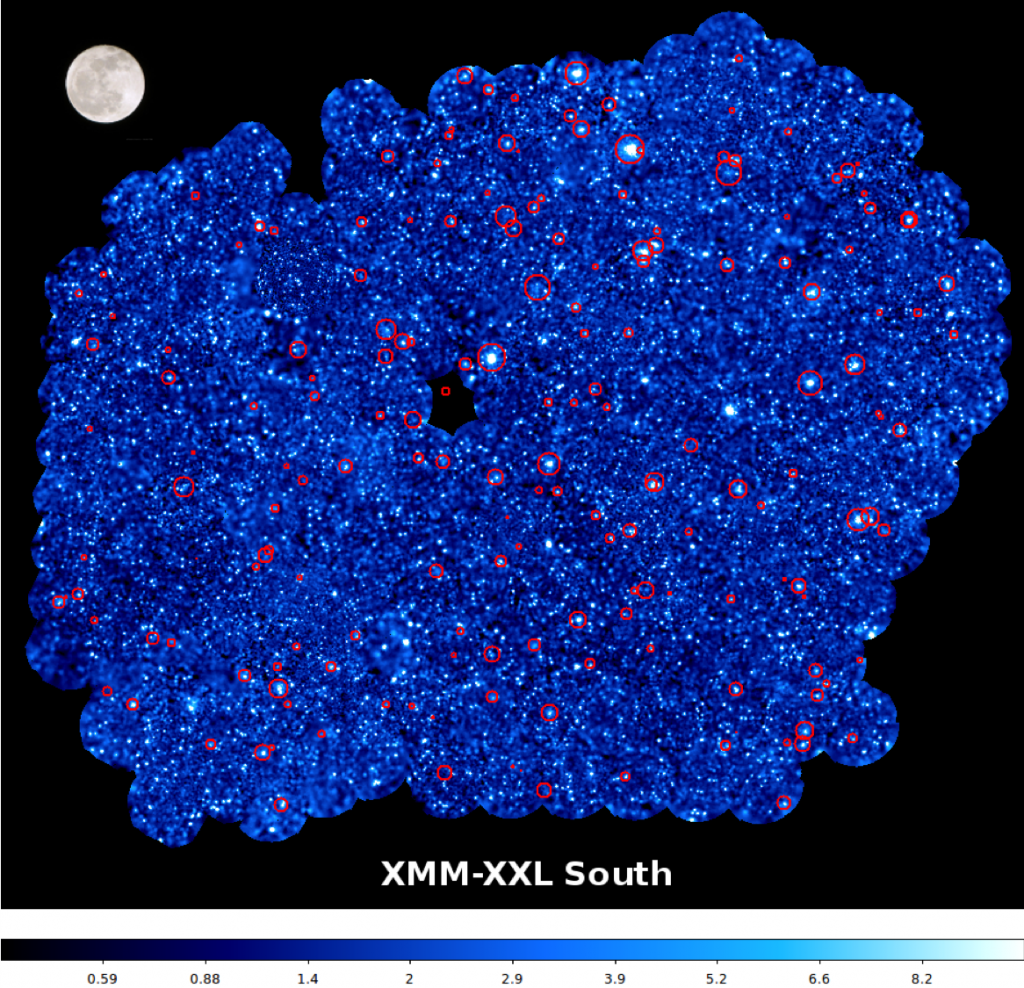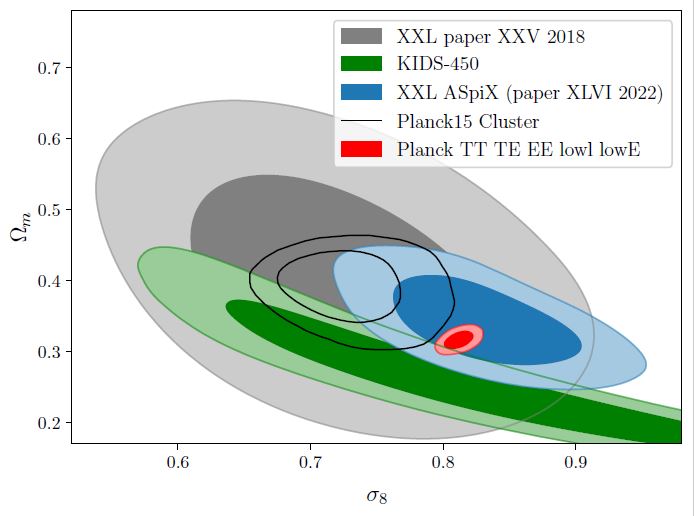For the first time since the XMM launch (1999), a cosmological analysis constraining the density of matter in the universe, from a catalog of 178 galaxy clusters detected by XMM, has been possible and in an autonomous way, i.e. with its own distance measurements and without calling upon additional information from numerical simulations or other cluster samples. This analysis was conducted in the framework of the XXL consortium, mainly by Christian Garrel during his thesis at the Astrophysics Department (DAP) of CEA Paris-Saclay (see the article on arXiv).. The results confirm the standard cosmological model in a completely independent way, with an accuracy rivalling with other probes covering much larger portions of the sky. The existing “cosmological” tension between the cosmological analyses of the clusters and the CMB PLANCK is thus lifted; there is no longer any need to use massive neutrinos.
This cosmological analysis from clusters has been possible thanks to the new method ASpiX, developed at DAP allowing to model properly the distant clusters. In the distant Universe, we only detect massive clusters, thus blue, which appear red because of the expansion of the Universe. Mathematically, the software analyses all possible combinations of the effect of cosmology on the properties of clusters.
The cosmological analysis exploiting all the observations of the XXL program is in progress and will include about 300 clusters. The novelty is that it will combine the ASpiX method with artificial intelligence techniques that allow identifying very quickly the cosmological model that best reflects the observed properties of the cluster population.

Cosmological analysis with clusters of galaxies
Clusters of galaxies are the most massive entities in the universe. Their formation results from the competition between two opposite processes operating in the long term: in one hand, there is the gravity, the dominant force at large scales that forces matter to assemble. In other hand, there is the expansion of the universe that opposes this effect.
This gives rise to an astonishing three-dimensional network of filaments and sheets delimiting immense cosmic voids; the clusters of galaxies are at the intersection of the filaments (cf. Figure).
The statistical study of the properties of clusters as a function of the age of the universe allows us to obtain valuable information on certain cosmological parameters such as the density of matter and the nature of the expansion.
In the hypothesis that the universe is more or less dense, or the expansion more or less accelerated, the clusters will form more or less quickly. In this sense, clusters are complementary cosmological probes to the cosmic microwave background, supernovae, galaxy distribution or gravitational shear.

XMM-Newton XXL observation program
In this context, the XXL survey covered two 50 deg2 fields on the sky (200 times the surface of the moon) with the XMM-Newton space observatory (see this previous highlight), a mission in which the Astrophysics Department of CEA Paris-Saclay was deeply involved. With some 80 days of observing time, XXL is the largest XMM-Newton project to date. Its main goal is to conduct cosmological studies from galaxy clusters detected in X-rays, thanks to a meticulous identification procedure.
The XMM-XXL observations, combined with an exceptional multi-wavelength coverage in collaboration with the largest observatories, have could infer the statistical properties of a subsample of 178 clusters. This information allows establishing the relationships between different observable parameters of the clusters (such as the X-ray flux or the temperature) and their mass. The collection and processing of these data requires a meticulous and long work, because the detected objects are mostly distant and therefore very weak.
For the first time, it is possible to obtain cosmological constraints from a sample of clusters detected by XMM, and in a self-sufficient way (without additional information from numerical simulations or other cluster samples). The measurement of cluster distances has been the subject of many ground-based spectroscopic observation campaigns.
ASpiX analyzes the interdependence of the X-flux (combination of luminosity and distance) and X-color (combination of temperature and distance) of the cluster population as a function of the redshift. Following the General Relativity, one have these three cosmological effects on clusters:
- The further away a cluster is, the more its X-color is redshifted and the weaker its flux is.
- But the weaker the clusters are, the less they are detectable: in the distant universe, we only detect massive clusters, thus blue.
- So the more blue the clusters are, the more far they are, the more red they appear to us …
Mathematically, the software analyses all possible combinations of the effect of cosmology on the properties of clusters. It is very time consuming, about several weeks at the IN2P3 Computing Center. At the end, the results confirm the standard cosmological model in a completely independent way, reaching an accuracy rivalling with other probes covering much larger portions of the sky (Fig. opposite).
The article XXL XLVI presents the results of this cosmological analysis. It was mainly conducted by Christian Garrel, during his thesis at the Astrophysics Department.
This article published with 21 new articles [1] closes the series III of the publications of the XMM-XXL project. The other papers of the series study the properties of the clusters and AGN detected by XXL (about 100 times more numerous than the clusters!) and report a profusion of new results, in particular for very distant subsamples.
In total, 57 papers including 7 in collaboration with the HSC consortium (wide field imager of the Subaru telescope in Hawaii) have been published since the beginning of the XXL project.

To be continued…
The next and final XXL series will compute a new analysis of the 690 XMM-Newton observations by 1x1deg2 tiles, exploiting the maximum depth of the survey.
The final cosmological analysis will include about 300 clusters and will combine the ASpiX method with artificial intelligence techniques.
Contact Irfu : Marguerite PIERRE
[1]The majority of the authors are European; the others are in Canada, Japan, Taiwan, Chile, US, Australia. In France, the LAM, the Observatoire de Nice and the IRAP [LMO1] are associated to the project. Twelve papers have a PhD student as first author, five a post-doc, five a senior astronomer. List of papers available on http://irfu.cea.fr/xxl
Project funded by CNES and PNCG
XMM-Newton is an ESA mission. CNES contributed to the financing of the satellite and contributes to the data processing, by supporting the French laboratories responsible for these activities.
Previous highlight:
2015: An X-ray survey in XXL dimensions
2018: Tracing the Universe: a new X-ray survey bring a new light


